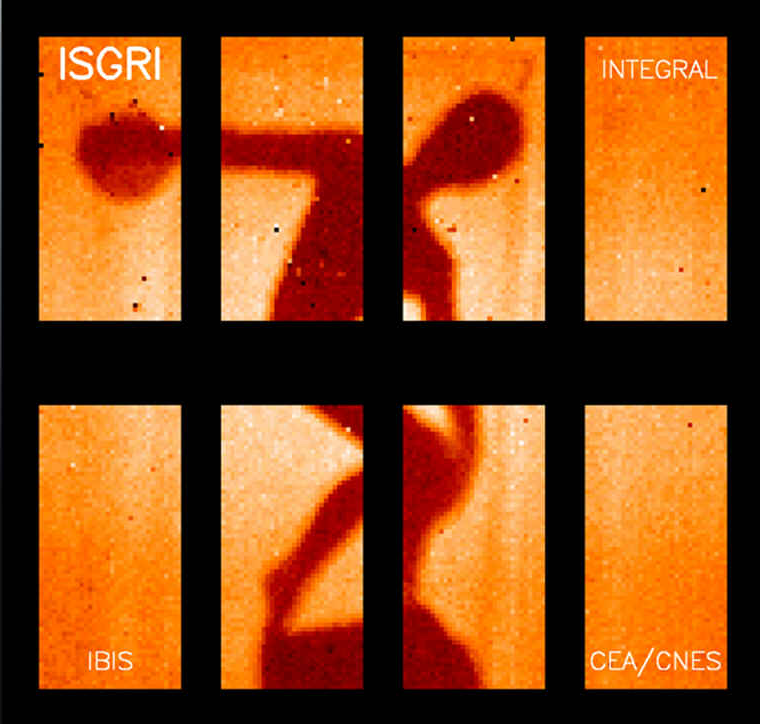The INTEGRAL satellite, (for INTErnational Gamma-RAy Laboratory), is a space observatory of the European Space Agency (ESA) for the study of the cosmic gamma-rays, which is planned to be launched in October 2002 by a russian rocket Proton, from the Baikonour cosmodrome in Kazakhstan.
The ISGRI gamma camera Delivery Review took place on the CEA premises in Saclay on July 6, 2001. One of the main scientific goals of the mission is the observation of the astrophysical sites where the largest energy transfers take place; with foremost the black hole environment. High sensitivity, fine imaging and spectral performance set the ISGRI camera as a key element for the INTEGRAL observing programme. With its 2600 cm2 sensitive area, ISGRI is the first gamma camera in the world equipped with semiconductor detectors operating at ambient-temperature. With more than 16 000 independent cadmium telluride (CdTe) detectors, this exceptional device, developped by the CEA with the CNES support, takes advantage of the latest progress in crystal manufacturing and microelectronics. ISGRI was delivered on July 12 to be integrated on the IBIS telescope.
The experience acquired at the SAp with the development and the exploitation of the SIGMA gamma camera has led us to look for new detectors for better imaging and spectral performances. Cadmium telluride is by all means a remarkable detector. This very dense semiconductor is very efficient to stop gamma-rays and measure precisely their energy. Cooling being unnecessary, it allows the design of large size gamma cameras by the assembly of many small detectors (e.g. 4x4 mm) each being a pixel.
The feasibility of such a device requires the development of a low power-consuming chip to process the signals delivered by the detectors. Such a dedicated integrated circuit (ASIC) able to process the signals of 4 pixels has been designed and realized.
| An hybrid element, called polycell, formed by the assembly of 16 detectors and 4 ASICs on a ceramic substrate has been developed . These elementary components are soldered on a printed circuit board to form a Modular Detection Unit (MDU) that contains 16x8 polycells. The signals delivered by the modules are encoded by the Module Control Electronics (MCE) so that each MDU-MCE chain is a fully independent gamma camera. With 8 such modules, ISGRI is a 128x128 pixel camera offering a spatial resolution of 4 mm, independent of energy. It operates in the 15-950 keV and provides much better spectral performance (8% à 122 keV) than e.g. the NaI scintillator used in the Sigma gamma camera.. |  |
|
Energy resolution |
The Delivery Review provided the opportunity to demonstrate the device imaging capabilities. For this test, the eight modules forming the detection array of the camera, were assembled on a test platform. To ease the mounting, large spaces were left between modules. In the final configuration on the IBIS telescope, the modules will be mounted side by side so that these dead zones will be ten times smaller.

A bronze statuette, a copy of the discobol, has been inserted between ISGRI and a cobalt 57 radioactive source, emitting photons with an energy of 122 kilo electron-volt. Bronze is a strong absorber at this energy and photons can hardly pass through, so that the statuette shadow is cast on the ISGRI module layer. However, one should note that, because it is thinner, the thin disc is less absorbing than the athlete's arm. The source being located 60 cm above the camera centre the count rate decreases significantly (from light orange to dark orange) from the centre to the edges that are farther from the source. Attention should also be devoted to the dark points in the image, corresponding to faulty pixels (noisy detectors). They number one hundred (i.e. less than 0,6%); this small number illustrates the quality of the manufacturing and justifies, a posteriori, the confidence in these new detectors. The specification was at less than 5% noisy detectors.
In a very emphatic way, the discobol symbolizes the intense effort before launch and the light announces the dawn of a prolific era for gamma-ray astronomy..
